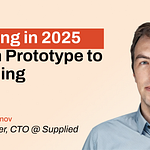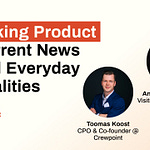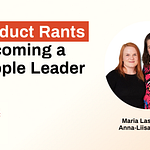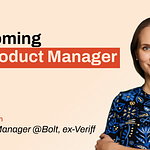For all YouTube fans, we’ve got something special: Tallinn Product Group now has its very own channel! 🎉 You’ll find our podcast videos and bite-sized insights in shorts format—perfect for learning and inspiration on the go.
✨ Subscribe to our channel today to stay updated and never miss a future episode!
Maria Saviste is Principal Customer Experience and Market Researcher at Katana, where she plays a key role in guiding strategic decisions for both business and product teams. Prior to Katana, Maria worked as a researcher at Telia, Pipedrive, and Whereby. She’s worked across various levels of research, always ensuring that her insights are not only solving customer problems, but helping to reach business goals.
In this episode we discuss:
Different levels of research;
How research is done in Katana;
How researchers keep focus on driving business goals;
Integrate research insights into product development;
How to be more effective in doing customer interviews;
How to ask questions;
Future of research.
Some takeaways
Research is most effective when aligned with company strategy and goals. Without a clear understanding of these priorities, research risks becoming scattered and less impactful.
To maximize engagement, research findings should be shared in multiple formats—written reports, workshops, discussing them 1:1 with key people and walkthroughs. Workshops and 1:1 discusssions lead often to best results and collaboration.
In B2B settings, recruiting users for interviews can be tough due to gatekeeping or limited sample sizes. Offering incentives is a "silver bullet" to overcome these challenges, coupled with thoughtful timing and targeting the right personas.
To avoid overwhelming users, it’s essential to implement a "grace period" between outreach efforts, ensuring customers aren’t repeatedly contacted by different teams.
Tools like Dovetail for research and DataBricks AI/BI Genie for natural language data querying can streamline processes and empower researchers to explore product data independently.
Maria’s recommendation for getting better at doing interviews:
Steve Portigal’s article on interviewing: https://medium.com/user-research-explained/great-user-research-for-non-researchers-part-2-f8cae9f434a2
Book recommendation - Interviewing Users: How to Uncover Compelling Insights: https://portigal.com/Books/interviewing-users-2/
Episode timestamps:
01:47 Levels of research
06:04 how research works in Katana
07:29 setting goals for research
08:41 research sources
10:34 aligning research with business goals
11:20 importance of business strategy
12:20 how research can change the strategy
14:51 how to prioritise research between product and strategic level
15:50 how to make sure research insights are used in product development
19:10 best formats for engaging people with research insights
22:45 how to work through data from different inputs
26:23 can you get new insights from data you already have
27:43 getting a full picture from different data sources
30:05 importance of understanding the data
33:10 getting customers into interviews
36:37 understanding who is the right user to interview
38:08 what is a good incentive for interviews
39:27 how to make sure customers are not overwhelmed by communication
41:58 product managers doing research
43:55 being more efficient in doing interviews
45:23 how to ask questions
47:20 what researchers can learn from PMs
48:24 how to cope with uncertainty
50:19 future of research
Connect with us
Maria Saviste - https://www.linkedin.com/in/maria-saviste/
Janika Liiv - https://www.linkedin.com/in/janikaliiv/
Katana - https://katanamrp.com/
References
How much to pay research participants as an incentive - https://www.userinterviews.com/lp/ux-research-incentive-calculator
Ultimate guide to user research incentives https://www.userinterviews.com/blog/the-ultimate-guide-to-user-research-incentives
Align - https://getalign.com/
DataBricks AI/BI Genie - https://www.databricks.com/product/ai-bi/genie













